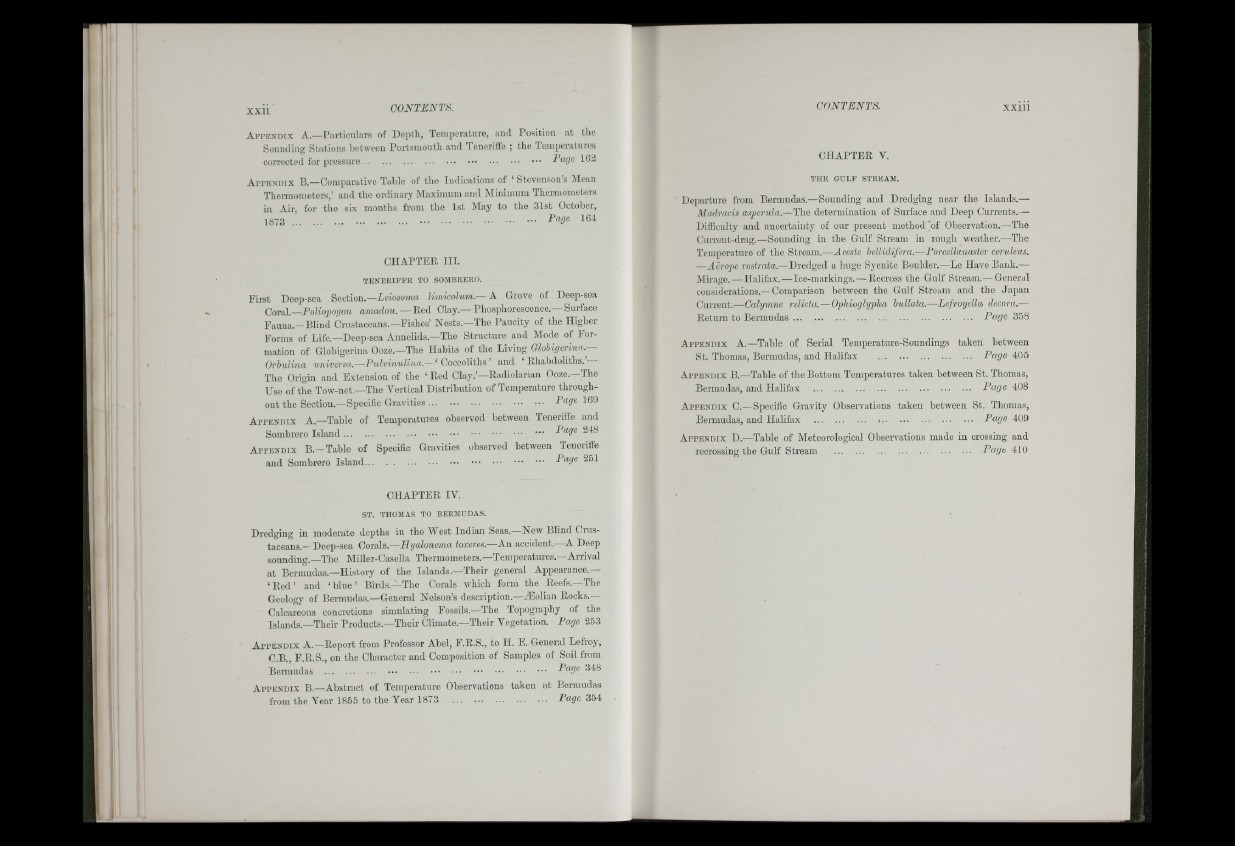
A p p e n d ix A.—Particulars of Depth, Temperature, and Position at the
Sounding Stations between Portsmouth and Teneriffe ; the Temperatures
corrected for pressure..................................................................... Page 162
A p p e n d i x B .— Comparative Table of the Indications of ‘ Stevenson’s Mean
Thermometers,’ and the ordinary Maximum and Minimum Thermometers
in Air, for the six months from the 1st May to the 31st October,
1873 ............................................ -P“?®
CHAPTER III.
t e n e r i f f e t o SOMBRERO.
First Deep-sea Section.—Leiosoma limicolum.— A Grove of Deep-sea
Goral—Poliopogon amadou. — Red Clay.— Phosphorescence.— Surface
Fauua.-Blind Crustaceans.—Fishes’ Nests.—The Paucity of the Higher
Forms of L i f e .— Deep-sea Annelids.—The Structure and Mode of Formation
of Glohigerina Ooze.—The Habits of the Living Glohigerina.—
Orhulina universa.—Pulvinulina.—‘ Coccoliths’ and ‘ Rhabdoliths.
The Origin and Extension of the ‘Red Clay.’—Eadiolarian Ooze.—The
Use of the Tow-net.—The Vertical Distribution of Temperature throughout
the Section.—Specific Gravities.................................................... ^
A p p e n d i x A .— Table of Temperatures observed between Teneriffe and
Sombrero Island..................................................................... "•
A p p e n d i x B.—Table of Specific Gravities observed between Tenerifie
and Sombrero Island..................................................................... -^“9« 251
CHAPTER IV.
ST. THOMAS TO BERMUDAS.
Dredging in moderate depths in the West Indian Seas.—New Blind Crustaceans.
Deep-sea Corals.—Hyalonema toxeres.— An accident.—A Deep
sounding.—The Miller-Casella Thermometers.—Temperatures.—Arrival
at Bermudas.—History of the Islands.—Their general Appearance.—
‘Red’ and ‘blue’ Birds.—The Corals which form the Reefs.—The
Geology of Bermudas.—General Nelson’s description.—/Eolian Rocks.—
Calcareous concretions simulating Fossils.—The Topography of the
Islands.—Their Products.—Their Climate.—Their Vegetation. Page 253
A p p e n d i x A.—Report from Professor Abel, F.E.S., to H. E. General Lefroy,
C.B., F.R.S., on the Character and Composition of Samples of Soil from
Bermudas ..................................................................................... -^«96 348
A p p e n d ix B.—Abstract of Temperature Observations taken at Bermudas
from the Year 1855 to the Year 1873 354
CHAPTER V.
THE GULF STREAM.
' Departure from Bermudas.—Sounding and Dredging near the Islands.—
Madracis asperula.—Tl\o determination of Surface and Deep Currents.—
Difficulty and uncertainty of our present method 'of Observation.—The
Curreut-drag.—Sounding in the Gulf Stream in rough weather.—The
Temperature of the Stream.— Aceste hellidifera.—Porcellanaster ceruleus.
—Aei'ope rostrata.—Dredged a huge Syenite Boulder.—Le Plave Bank.—
Mirage. — Halifiix. — Ice-niarkings. — Eecross the Gulf Stream.— General
considerations.—Comparison between the Gulf Stream and the Japan
Current.— Calymne relicta.— Ophioglypha bullata.— Lefroyella decora.—
Return to Bermudas..................................................................... Page 358
A p p e n d ix A.—Table of Serial Temperature-Soundings taken between
St. Thomas, Bermudas, and Halifax .................................. Page 405
A p p e n d ix B .— Table of the Bottom Temperatures taken between St. Thomas,
Bermudas, and Halifax ............................................................. Page 408
A p p e n d ix C.— Specific Gravity Observations taken between St. Thomas,
Bermudas, and Halifax Page 409
A p p e n d ix D.—Table of Meteorological Observations made in crossing and
recrossing the Gulf Stream .................................................... Page 410